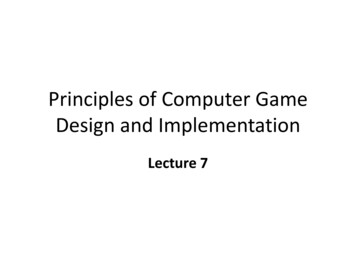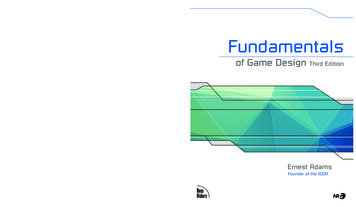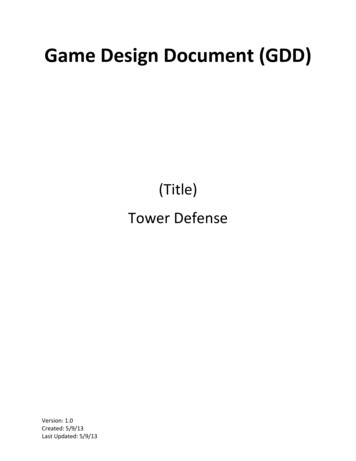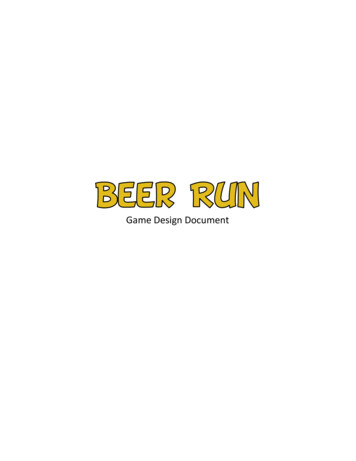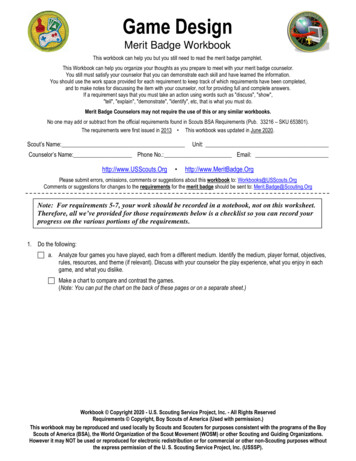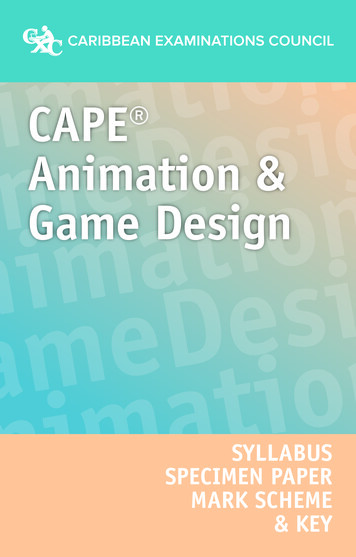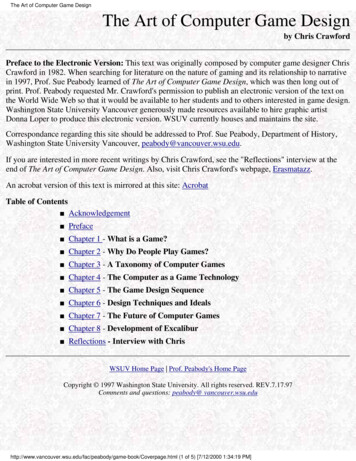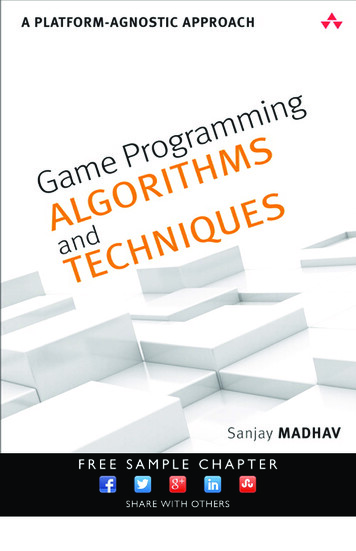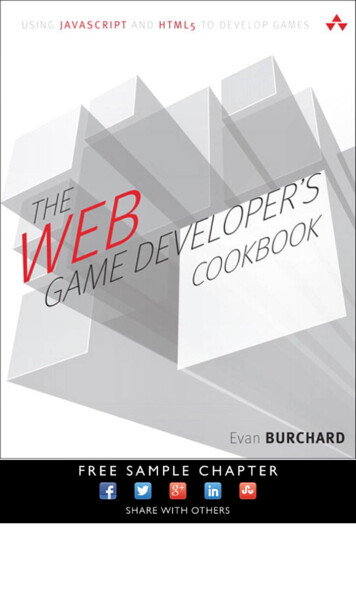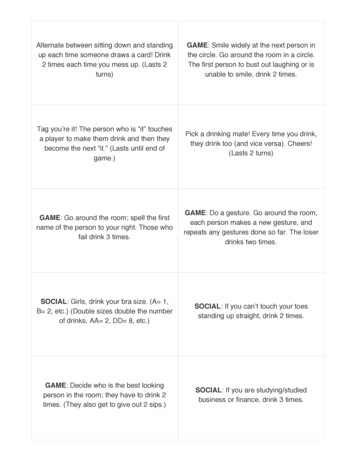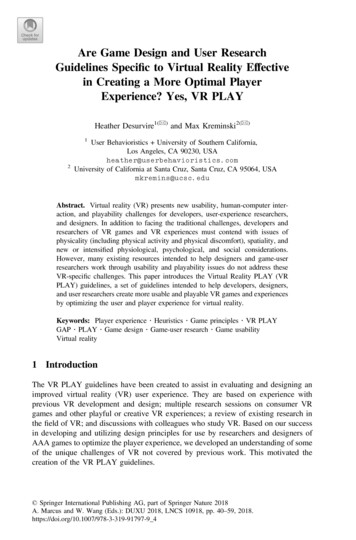
Transcription
Are Game Design and User ResearchGuidelines Specific to Virtual Reality Effectivein Creating a More Optimal PlayerExperience? Yes, VR PLAYHeather Desurvire1(&) and Max Kreminski2(&)12User Behavioristics University of Southern California,Los Angeles, CA 90230, USAheather@userbehavioristics.comUniversity of California at Santa Cruz, Santa Cruz, CA 95064, USAmkremins@ucsc.eduAbstract. Virtual reality (VR) presents new usability, human-computer interaction, and playability challenges for developers, user-experience researchers,and designers. In addition to facing the traditional challenges, developers andresearchers of VR games and VR experiences must contend with issues ofphysicality (including physical activity and physical discomfort), spatiality, andnew or intensified physiological, psychological, and social considerations.However, many existing resources intended to help designers and game-userresearchers work through usability and playability issues do not address theseVR-specific challenges. This paper introduces the Virtual Reality PLAY (VRPLAY) guidelines, a set of guidelines intended to help developers, designers,and user researchers create more usable and playable VR games and experiencesby optimizing the user and player experience for virtual reality.Keywords: Player experience Heuristics Game principles VR PLAYGAP PLAY Game design Game-user research Game usabilityVirtual reality1 IntroductionThe VR PLAY guidelines have been created to assist in evaluating and designing animproved virtual reality (VR) user experience. They are based on experience withprevious VR development and design; multiple research sessions on consumer VRgames and other playful or creative VR experiences; a review of existing research inthe field of VR; and discussions with colleagues who study VR. Based on our successin developing and utilizing design principles for use by researchers and designers ofAAA games to optimize the player experience, we developed an understanding of someof the unique challenges of VR not covered by previous work. This motivated thecreation of the VR PLAY guidelines. Springer International Publishing AG, part of Springer Nature 2018A. Marcus and W. Wang (Eds.): DUXU 2018, LNCS 10918, pp. 40–59, 2018.https://doi.org/10.1007/978-3-319-91797-9 4
Are Game Design and User Research Guidelines Specific to VR Effective41The VR PLAY guidelines are intended to assist designers and game-userresearchers of VR games when working through usability and playability issues thatare unique to, or intensified by, VR. The guidelines can be found on a public -play. They consist of five categories:Usability, Playability, VR Immersion, Creative VR, and New Player Experience. Eachguideline contains a short summary suggesting a principle that designers andresearchers may use to gain insight into their own games; a longer explanation of thereasoning and principles behind the guideline; and examples of existing VR games andsoftware that adhere to or violate the guideline, demonstrating how the guideline maybe used. This paper introduces the guidelines, describes how they were developed, andpresents a study that lends support to the validity of the guidelines as a design tool.In our study, the guidelines were introduced to the designer of an existing VRexperience developed for the Vive VR system. The experience was sponsored by anddeveloped for Steelcase in conjunction with the Mobile & Environmental Media Lab atthe University of Southern California. After being introduced to VR PLAY, thedesigner created a revised version of the experience. Each player in the study wasexposed to two versions of the VR experience: Version A (designed without use of theguidelines) and Version B (designed with the guidelines in mind). We conductedinterviews with the designer to evaluate his understanding of the VR PLAY guidelines,and we performed a side-by-side evaluation of player experiences in the two versions todetermine if the guidelines had a significant positive impact on the designer’s understanding of player-experience issues and the usability and playability of the reviseddesign. These findings support the utility of the VR guidelines in improving the playerexperience.The study identified many useful principles. These included UI design, spatiality,physicality, and some playability components. Most of these were specific to VR andnot found in other guidelines. Two guidelines concerning the halo effect and VR ethicswere found to be not directly actionable but nevertheless helpful to the designer in anadvisory context. In addition, several guidelines—especially those concerning challenge, pace, and intermediate and long-term goals of the game—were not applicable inthis study. These guidelines pertained to specific gameplay experiences not present inthe current study’s VR design. To evaluate these guidelines, the authors plan to conducta study with a VR game that includes the relevant gameplay experiences.Altogether, the study found the guidelines to be significantly useful when evaluating the usability and playability of existing games and when designing and optimizing the player experience in new VR games.1.1Motivation for VR PLAYVirtual reality is an emerging medium with significant potential to enrich experiencesin fields ranging from games and entertainment to health and creativity tools. As VRtechnology becomes increasingly accessible and affordable, the medium is undergoinga process of rapid expansion.VR experiences, in comparison to traditional game console and computer playerexperiences, pose several unique usability and playability challenges. The increasedimmersion has the potential to accentuate the negative and positive aspects of an
42H. Desurvire and M. Kreminskiexperience, for instance by inducing physical discomfort or motion sickness [34] evenas the higher fidelity of the experience instills in players a greater sense of satisfactionand delight [1]. In addition to considering all the usability and playability issues alreadyknown to exist in other digital games, designers of VR experiences must contend withissues of physicality (including physical activity and physical discomfort), spatiality,and new or intensified psychological and social phenomena [15]. Moreover, users andplayers of VR software and games are impacted by these new issues in a variety ofways. Some players may find they are especially sensitive to certain novel issues whilefor other players these very same issues may pass entirely unnoticed.Usability and playability in video games are well-studied subject areas. There areresources [2, 6–8, 21] available to designers who want to improve the usability andplayability of their game designs. Despite the growing popularity of VR, however, fewof these resources have been designed with VR in mind. As a result, designers andevaluators of VR games and other VR play experiences have largely been left to theirown devices in dealing with some of the novel challenges posed by VR.To address such issues, we have created the VR PLAY guidelines. These guidelinesfor usability and playability can be used in two ways: as a set of heuristics againstwhich existing VR games and play experiences can be evaluated, and as a design toolintended to inform the development of new VR games. To demonstrate the effectiveness of these guidelines as a design tool, we have employed them in a case studyinvolving the revision of a work-in-progress playful VR experience.1.2Development of VR PLAYIn developing the VR PLAY guidelines, we drew on existing research in usability andplayability for games and other software and on research in VR itself, includingphysical, psychological, social, and ethical perspectives on VR. We also conducted ourown user research on VR games, have extensive experience with player research on VRgames, and gleaned further information from discussions with other VR researchers.We divided the information we collected into several categories, each of which weconcluded the guidelines should represent.GAP and PLAY Principles. The Game Approachability Principles (GAP) [6, 14] andthe Playability Principles (PLAY) [7] are two sets of heuristics or principles pertainingto general game usability and playability. The GAP heuristics deal primarily withissues of new-player experience and the processes by which players learn how to play anew game. The PLAY heuristics are broader in scope, encompassing a wide variety ofissues that range from enduring play and player motivation to usability and userinterface design. Both sets of principles have proven useful in our own research on over60 games with AAA clients over the last several years, and countless other companieshave used them successfully too. They have also been taught to over 150 students at theUniversity of Southern California, one of the top universities that offer interactivemedia and games as a major. The students report using them in their own work now,including work for AAA publishers and indie studios.
Are Game Design and User Research Guidelines Specific to VR Effective43VR PLAY Guidelines. Due to their generality, both the GAP and the PLAY heuristicsare largely platform agnostic. Consequently, most of the advice they offer is applicableto VR. At the same time, however, these principles do not specifically address usabilityor playability issues that are unique to VR. Thus, adherence to these principles could bedescribed as “necessary but not sufficient” for designers who wish to create positiveplayer experiences in VR. In assembling the VR PLAY guidelines, we chose to includeadapted and consolidated versions of the most important GAP and PLAY heuristics tohighlight the general usability, playability, and new-player-experience issues that arelikely to have the greatest impact on VR games.Presence. One advantage of VR experiences over traditional video games and othersoftware is the user’s or player’s increased sense of presence: the subjective perceptionthat they are physically present in the virtual environment [5, 22]. Several forms ofpresence have been proposed, including social presence [10] and behavioral andcognitive presence [11, 24]. Presence can also be measured in several ways [3, 12, 17,24, 27, 29, 34].Presence is a key element of immersion, as more coherent experiences—in whichmultiple aspects of the experience, such as visuals and audio, work together to createthe illusion of a “real” continuous world—are generally perceived by players as moreimmersive overall. Players who experience a heightened sense of presence feel thattheir experiences in the virtual environment are more “real” and thus more enjoyablewhen the experience itself is a positive one. They may also feel that their actions aremore meaningful or consequential. As a result, creating and maintaining a sense ofpresence can be an important tool for improving the player experience in VR andnon-VR games alike.Embodiment. A factor closely related to presence is embodiment: the extent to whichthe player in a virtual environment identifies with the body of the player character andfeels as though they are truly inhabiting it. Embodiment of the player character can befacilitated in a variety of ways, including by allowing the player to observe the waytheir actions directly map to equivalent actions by the player character (e.g., in a virtualmirror) [30]. Embodiment of certain characters may also pose ethical concerns, such aswhen a player inhabits the body of a character who commits violent actions [19].Embodiment, like presence, is a key element of immersion. It can serve to furtherengage players in the experience by presenting them with the opportunity to embodycharacters they find particularly compelling. Many players find it enjoyable to engagein role-playing by temporarily taking up some of the attitudes and decision-makingstrategies of the character they are currently embodying, rather than maintaining theirown real-life perspective during gameplay. In this sense, embodiment can be seen as akey contributor to player delight [2].Ethics. Due to the heightened sense of presence and embodiment, VR environmentsoften feel more similar to the real world than virtual environments in traditional videogames. This greater sense of reality is accompanied by increased ethical issues [9, 19,30]. For instance, research has shown that playing a first-person shooter game with arealistic gun-replica controller rather than a traditional mouse can lead to heightenedlevels of aggression in players [16]. Because players in VR experiences may experience
44H. Desurvire and M. Kreminski“bleed” between the real and virtual worlds to a greater degree than players of traditionalvideo games, it is especially pressing that designers of VR experiences take ethicalaspects into consideration [2].An especially acute example of an ethical issue related to VR can be found in theinteraction between VR and post-traumatic stress disorder (PTSD). Due to their perceived “reality,” VR experiences may trigger PTSD flashbacks, causing players tosuddenly and unexpectedly relive their memories of past traumatic events. Since a playerwho is experiencing a PTSD flashback may not have the presence of mind to remove theVR headset or otherwise disengage with the VR experience, it may be necessary toprovide an in-game safe space where players can recover. However, for the same reasonsthat VR experiences may act as triggers, they may also be applied to the treatment ofPTSD in the form of exposure therapy taking place in a VR environment [26].Physicality. Unlike traditional video games, which generally do not require high levelsof physical activity or exertion, VR experiences often involve a significant degree ofphysical activity. Designers of VR experiences must consider the players’ physicalcomfort; their physical ability to perform the actions that the game asks of them; theirneed for breaks or cooldown time between
Two guidelines concerning the halo effect and VR ethics were found to be not directly actionable but nevertheless helpful to the designer in an advisory context. In addition, several guidelines—especially those concerning chal-lenge, pace, and intermediate and long-term goals of the game—were not applicable in this study. These guidelines pertained to specific gameplay experiences not .
